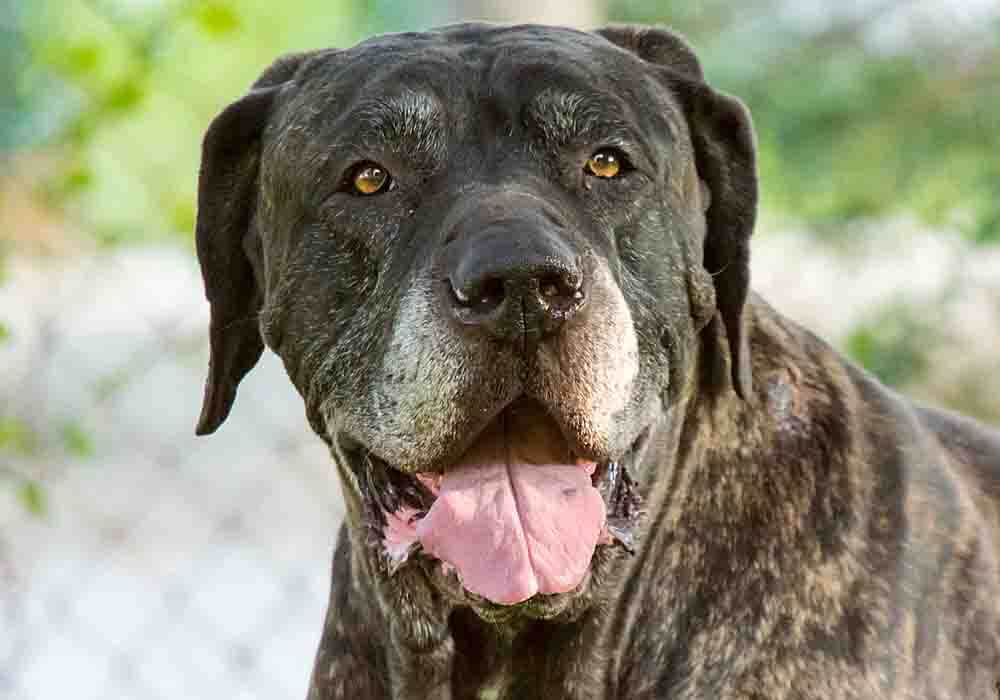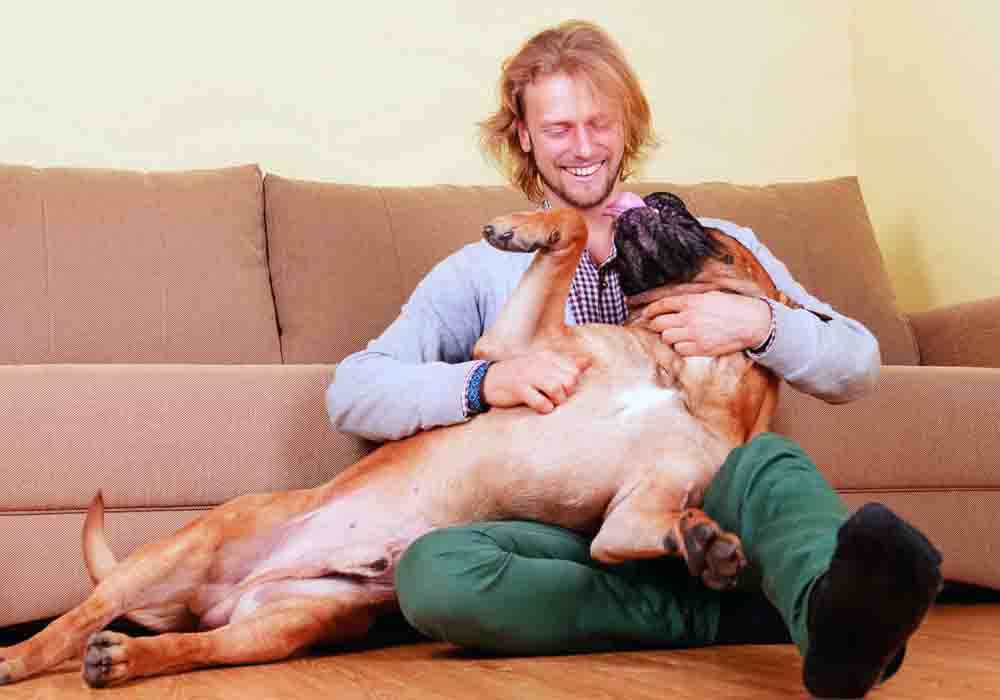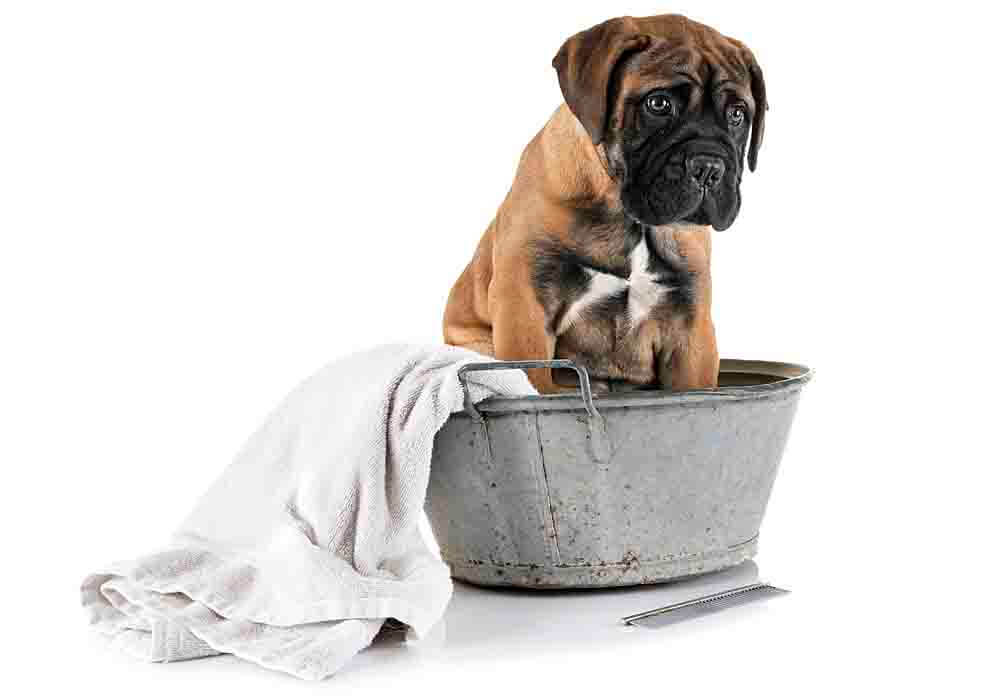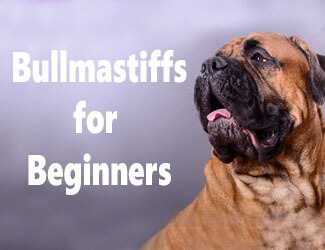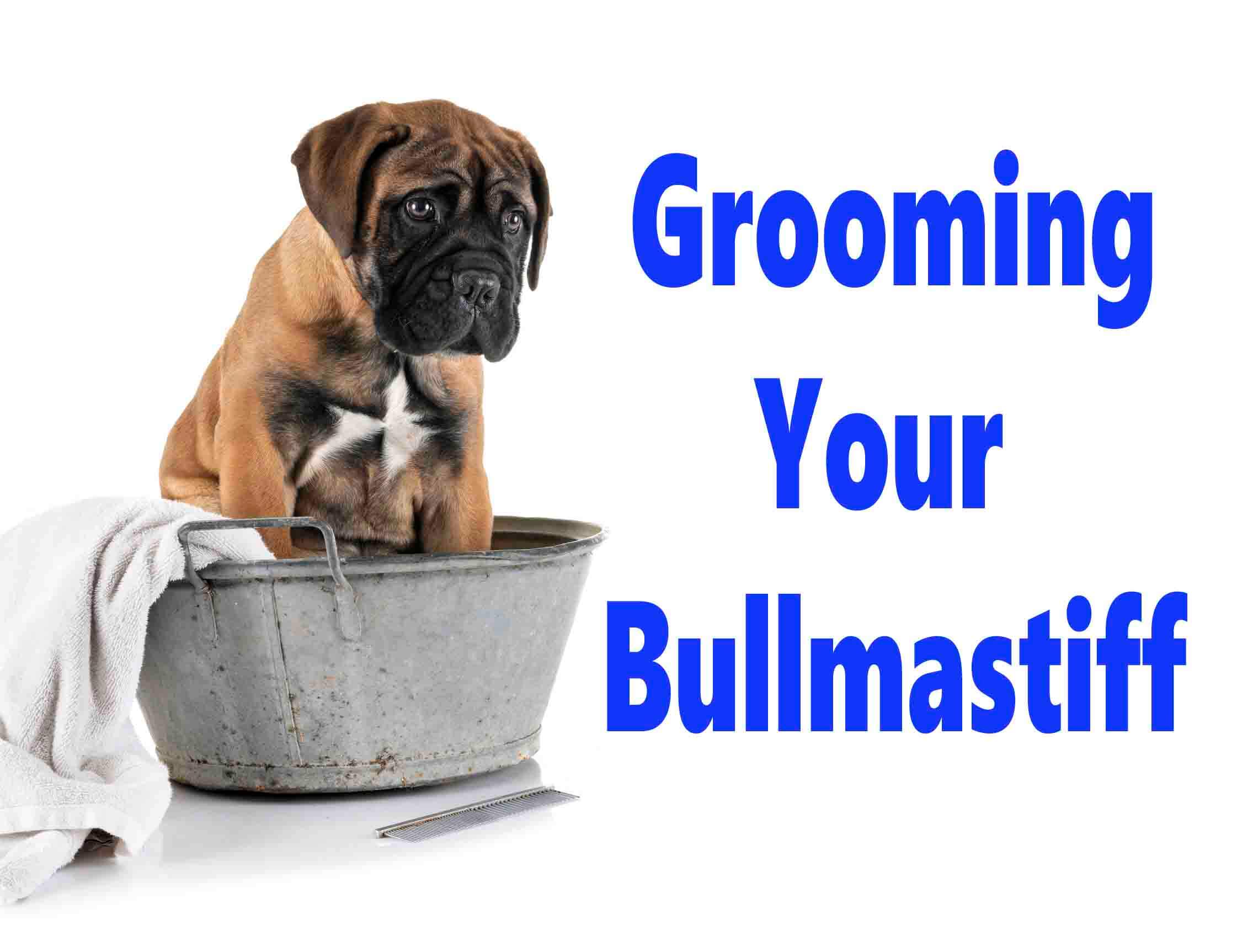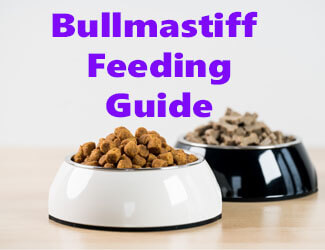How To Care For A Bullmastiff Guide
From Puppy To Adult
by Ken Alden
Bullmastiffs are large affectionate dogs that are loyal to their owners. While they are easier to care for than some other dog breeds, they still require proper nutrition, grooming, and exercise to stay healthy.
How To Care For A Bullmastiff Guide...
- Feed them several small meals per day of high quality wet & dry food
- Socialize them as puppies
- Take note of any potential health problems
- Groom them regularly to reduce shedding and odors
- Provide them with moderate daily exercise
- Keep them indoors to reduce the chance of overheating
Below, you will learn even more on how to care for a bullmastiff from puppyhood to adulthood. Read More Below..
Pro-tip: Ever try lifting a Bullmastiff? Their weight can hurt not only your back but their joints when they hop down from cars, sofas or even your bed. To protect your back and theirs check out the best Mastiff ramps on Amazon.com now.
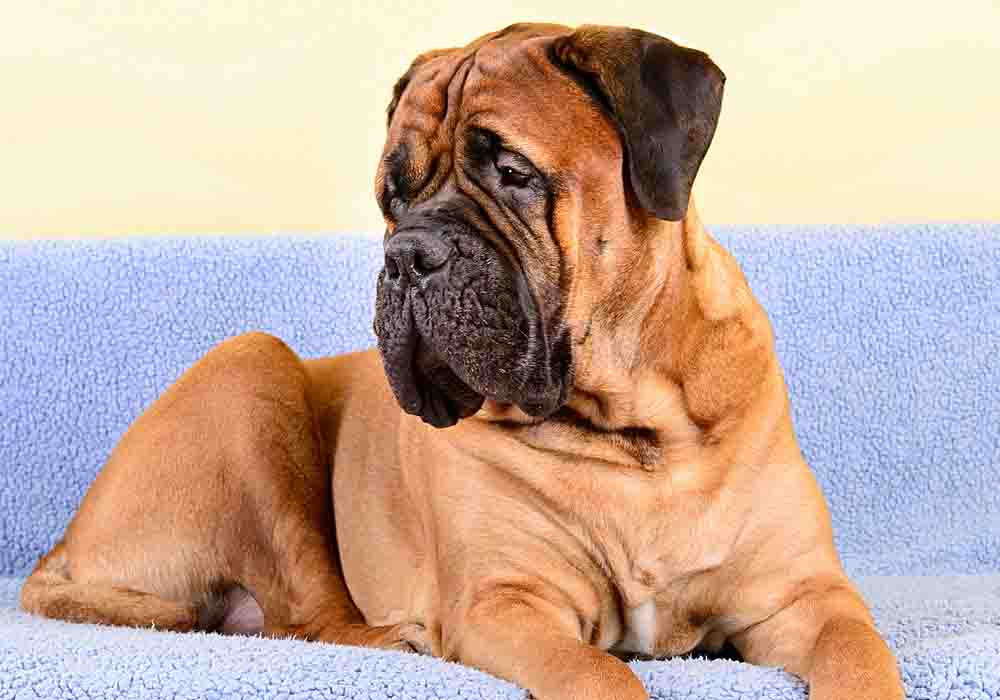
How to Care for a Bullmastiff Puppy
Bullmastiff
puppies are simply adorable. They have dark muzzles and red, fawn, or brindle coats. As with any puppy,
bullmastiff puppies require a lot of care and training to develop into healthy
and well-mannered adults.
Potential Bullmastiff Puppy Health Problems
Bullmastiff puppies rapidly grow, which can cause
certain bone diseases to develop, especially among males. Some of the most prevalent diseases
include:
Hypertrophic Osteodystrophy (HOD) causes intense pain, swelling, and lameness of the limbs. The cause of this disease is unknown, and it is incurable. However, pain management techniques and medication can help regulate their symptoms.
Osteochondritis Dissecans (OCD) is a disease that affects puppies' cartilage, often causing terrible joint pain. The main symptom of OCD is limping. Treatment includes an adjusted diet, pain management treatment, and confinement. In severe cases, the abnormal or damaged cartilage may be removed.
Panosteitis (Pano) is a condition in which the limbs experience sudden lameness. It is typically caused by rapid growth. The lameness can come and go for months on end before it will eventually go away on its own. Some treatment options to help with the lameness include rest, pain management, and preventing the pup from over exercising. Not managing the symptoms of pano can result in arthritis later in life.
Learn More: Here's a more in depth article on our site that covers health issues that Bullmastiffs are prone to. guide
Socializing Bullmastiff Puppies
Socialization is the process of introducing your puppies to different people, places, sounds, smells, and experiences. It is important to socialize Bullmastiffs while they are young since it will shape how comfortable they feel in different environments as adults.
Responsible breeders typically begin the socialization process a few days after the puppies are born. They will begin by exposing them to their immediate surroundings. They will also start petting them to make them feel comfortable with being touched. Once your puppies are home with you, you should start socializing them ASAP.
When socializing puppies to touch, start slow. Puppies are typically sensitive on their paws, tail, feet, and ears. Select one of these locations to work on first. If you choose to start with the ears, for example, pet one ear at a time. Make the experience as positive as possible by praising them and providing them with small treats whenever you touch their ears.
One of the best ways to introduce Bullmastiffs to new sights, sounds, and smells is by taking them outside. To do this, simply go for a stroll with your pups. Allow them to observe their surroundings. Don’t pull them or scold them if they want to spend a long time looking at something.
Remember, they are new to the world, so they are seeing many things for the first time. Whenever the puppies interact with something new, praise them and give them treats. How to care for a Bullmastiff guide
Puppies can get overwhelmed easily, so you shouldn’t introduce them to too many strangers at a time. You want every experience they have with a new person to be a positive one, not frightening. Start by introducing your pups to one or two family members, then slowly introduce them to other people.
Bullmastiffs benefit from puppy classes. These classes expose them to new dogs and people in a controlled setting. The trainer who runs the puppy sessions will know how to introduce your puppies to new dogs in a non-threatening way.
You should also introduce your Bullmastiffs to other puppies and adult dogs outside of the puppy class. If you see another friendly dog on a walk, allow your puppies to meet them. This will make them feel more comfortable around dogs of all ages and sizes in the future.
Bullmastiffs should be socialized when they are young. Older bullmastiffs who weren’t exposed to different people, pets, and situations can be easily frightened and may become aggressive.

Here's a great article of ours about additional socialization tips as well as fun games you can play with your dog while he's learning!
Pro-tip: Bullmastiff anxiety, aggression, destructive chewing, jumping up, fearfulness, and other behaviors can be controlled with the right training program.
Here’s a great course that
addresses these issues along with many other dog training basics: Check it out now!
Bullmastiff Puppy Nutritional Requirements
It is recommended that bullmastiff puppies eat large-breed puppy food. This type of food provides growing puppies with all of the nutrients they need to grow into large, well-formed adults.
Large breed puppy food is different from regular puppy food because it has a lower energy density and regulated calcium levels. Large-breed puppies should not have too much calcium in their diet as it can lead to bone and hip problems.
Before you feed your puppies, read the nutritional information
on the back of their puppy food bag. It will tell you the appropriate amount of
food to feed the pups, depending on their current weight. Puppies’ weights
change a lot within their first year, so weigh your puppies regularly to make
sure you are feeding them enough.
Below we will go over three highly-rated large-breed puppy food brands for puppies.
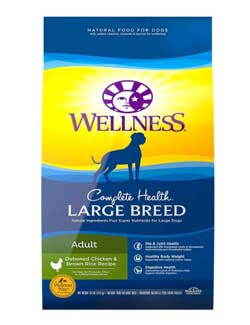
Wellness Complete Health Large Breed Puppy Food from Amazon
Wellness Complete Health Large Breed Puppy Food is a wholesome food that will aid in your puppies growth. Its ingredients were carefully chosen to provide your bullmastiffs with the nutrients they need to grow big and strong.
This amazing dog food promotes bone and teeth growth, healthy brain development, nutrient absorption, and muscle growth.
The first five ingredients in this dog food are deboned chicken, chicken meal, peas, ground brown rice, and salmon meal. These healthful ingredients will provide your pups with a diet rich in protein and fat.
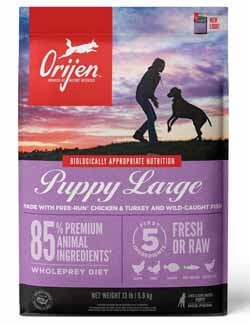
ORIJEN Puppy Large Dog Food from Amazon
Puppies need a lot of meat in their diet for healthy development. ORIJEN makes all of its dog foods with high-quality meat as the number one ingredient. This provides your pet with a perfect protein-packed meal. Some of the ingredients they use are free-run chicken, free-run turkey, wild-caught fish, and cage-free eggs.
Additionally, ORIJEN Puppy Large Dog Food only provides puppies with the nutrients they need. This helps prevent them from becoming overweight. Maintaining a healthy weight is important since it prevents added stress on your puppies growing bones and joints.
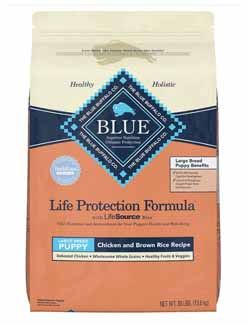
Blue Buffalo Life Protection Large Breed Puppy Food from Amazon
Blue Buffalo Life Protection Large Breed Puppy Food includes healthful ingredients that encourage proper development. Every bite is packed with high-quality meats, fruits, and vegetables.
This dog food contains DHA and ARA, which are essential fatty acids found in puppies’ mothers' milk. These are essential for cognitive functioning and good eye health.
The kibble was specially designed to be the perfect size for your growing puppies’ jaws. It was also made in a unique way that aids in tartar removal, helping to keep your puppies’ teeth healthy and strong.
Learn More: Many owners prefer to feed their dog a raw food diet instead of canned or dry food. Since eating raw food can be a very healthy alternative for your dog, we have an article dedicated to this type of feeding.
Bullmastiff Puppy Feeding Schedule
It is recommended that you feed your Bullmastiff puppies several small meals each day. Bullmastiffs tend to have bloating problems, so feeding them small amounts of food at a time makes it easier to digest. Simply divide their daily food allotment into three or four servings that you can give them throughout the day.
If you aren’t able to be with your puppies all
day long, you may want to invest in an automatic dog food dispenser. These
machines can dispense a set amount of food multiple times each day, providing
your bullmastiffs with perfectly portioned meals. One highly rated pet food
dispenser is the Westlink
Automatic Pet Feeder from Amazon. This feeder holds 25
cups (6 L) of food and can feed your pets up to four times per day.
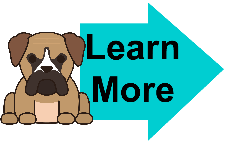
The topic of feeding your Bullmastiff deserves far greater coverage than just a few paragraphs on one page. That's why we wrote a whole page dedicated to feeding your Bullmastiff.
Bullmastiff Puppy Obedience Training
Bullmastiffs are smart but stubborn. You’ll want to provide them with obedience training while they are still small and impressionable. It’ll be much harder to train them when they are just as strong as you are.
Dogs learn best from positive reinforcement. Whenever your puppies do what you want them to do, provide them with lots of praise and treats. When they do the opposite, simply ignore them or say “no” sternly. Do not physically harm them. This will only make them afraid of you, not listen to your directions better.
Bullmastiffs respond to strong and confident trainers. Always be
firm and consistent with your training techniques. For example, if you don’t
want your puppies to jump on visitors, you shouldn’t let them jump on you
either.

Find a whole range of helpful training articles on this site that will soon have your dog being the most obedient mastiff on the block!
Get Comfortable With Grooming
While your Bullmastiffs are puppies, you should get them used to regular grooming activities, such as brushing, bathing, ear cleaning, and nail clipping. If you train your dogs to tolerate these activities while they are puppies, it will make it much easier to groom them later in life.
Make sure to socialize your dogs by touching sensitive areas of their body before attempting to groom them. For example, if you try to clip their nails before they are comfortable with having their paws touched, it will be a terrifying experience for them that may result in them hating nail clipping for the rest of their lives.
Living Requirements
Bullmastiffs do not do well in the heat. They have short muzzles that make it harder for them to breathe, making them more likely to experience heat exhaustion and heatstroke. Therefore, it is safest for Bullmastiff puppies to live indoors.
Don’t worry; Bullmastiffs are wonderful indoor dogs. While puppies can be a little more rambunctious and will likely have a couple of accidents, they’ll grow into relaxed adults who are ideal for apartment or condo living. The main thing you’ll have to worry about is drool. Bullmastiffs drool a lot, so you may want to cover up any furniture that can’t take a little slobber.
Even though bullmastiffs are indoor dogs, you’ll still need to
take them outside regularly for walks and potty breaks.
Bullmastiff Puppy Exercise Requirements
Taking your puppies for regular walks is a great way to get them moving. Another great exercise is playing with other puppies. Just make sure your pups have all of their vaccinations before they interact with other dogs.
While your puppies need regular exercise, make
sure you don’t overdo it. Too much exercise can be detrimental to your
Bullmastiff puppies’ health, especially during periods of rapid growth. Whenever they are playing outside, make sure they have shade
and plenty of water to drink.
How to Care for a Bullmastiff Adult
Adult bullmastiffs are large and powerful. On average, males are between 25-27 in (63.5-68.6 cm) tall, and they weigh 110-130 lbs (49.9-104.3 kg). Females are between 24-26 in (61.0-66.0 cm) tall and weigh 90-110 lbs (40.8-49.9 kg).
Although their exteriors may be frightening, these dogs are affectionate on the inside. They are loyal companions who enjoy their owner’s company. Whether you are going on a short walk or lounging at home, bullmastiffs are the perfect companions.
Nutritional Requirements For Bullmastiff Adults
Adult bullmastiffs typically eat 2-3 cups of dog food per day. They generally eat dry kibble, unless your vet recommends otherwise. To determine exactly how much you should be feeding your pets, refer to your dog food’s weight chart.
Always feed your Bullmastiffs the appropriate amount based on their size. Feeding them too much can make them overweight, which can lead to several health problems.
Feeding Schedule For Bullmastiff Adults
As
mentioned in the puppy section, bullmastiffs have sensitive digestion systems,
and they are prone to bloating. It is recommended that you feed adult
bullmastiffs two meals per day. This helps them digest
their food more easily.
Potential Bullmastiff Health Problems
Bullmastiffs
are prone to several health issues. Some of the most common include:
- Elbow and hip dysplasia occurs when dogs have irregularly formed joints. Dogs with dysplasia may have difficulty walking up stairs, pain while walking or running, and/or a smaller range of motion.
- Bloat (AKA Gastric Dilation) is when the stomach fills up with air and twists. This contortion in the stomach prevents blood from flowing to other organs. If dogs eat then are immediately taken to do strenuous exercises, bloat can occur.
- Entropion is an eye disease experienced by wrinkly dog breeds. Typically, dogs' eyelids will invert, which causes their eyelashes to rub against their eyeballs. This can irritate their eyes and cause discharge, frequent watering, irritation, and infection. If dogs have this problem, surgery is the best way to fix it.
- Cancer is the leading cause of death for dogs over ten years old. The most common forms of cancer bullmastiffs are diagnosed with include mast cell tumors, lymphoma, hemangiosarcoma, and osteosarcoma. Cancer may be treatable if it is caught early on. Always bring your pets to the vet if you notice any physical or behavioral changes. how to care for a bullmastiff guide
Pro-tip: Bullmastiff's (and their owners) love dog crates…and for good reasons. Crates keep dogs from mischief while you're away, are perfect for house training, for traveling by car, and provide the dog a place to de-stress. Check out the best Mastiff crates on Amazon.com now.
Bullmastiff Socialization
There are several
signs you can look out for to determine if your adult Bullmastiffs weren’t
properly socialized.
- Extremely afraid or aggressive around other people and animals
- The hairs on their backs raise when people approach them
- They are incredibly shy around other people and dogs
- They are anxious on walks
Be warned; it’s more difficult to socialize adult dogs than puppies. Puppies are like sponges, so all you have to do is expose them to new things, and they will be able to accept them as normal. On the other hand, adult dogs are more fearful of new things and can quickly become aggressive if something scares them.
However, it is possible to socialize adult bullmastiffs. While they may never be as comfortable in new situations as they would have been if they were trained as puppies, they’ll likely still be able to interact with other dogs and people in a positive way.
Listed below are four tips you should follow when socializing your adult Bullmastiffs.
Put On a Muzzle
Mastiffs are big dogs that can become aggressive if something frightens them. To make other dogs and people feel more comfortable during socialization training, put a muzzle on your dogs whenever you go outside.
When your Bullmastiffs have a muzzle on, other people will feel safer approaching them, and you’ll likely feel less nervous as well. Your dogs can sense your emotions, so if you are calm while interacting with someone new, they’ll likely feel calm too and will realize they have nothing to be afraid of. How to care for a Bullmastiff guide
Go on Walks
Begin by walking your dogs around your neighborhood. This will introduce them to new sights, sounds, and smells in a non-threatening environment. If they become frightened, distract them with treats, their favorite toy, or move them away from the frightening situation. Praise your dogs whenever they interact with something unfamiliar in a positive manner.
When they are ready, you can take them to a dog park. Start on the outskirts of the park. If they are comfortable with this, allow them to smell the fence and look at other dogs playing inside the park. If they ever act frightened or aggressive, remove them from the fence until they are ready to try again.
Always Remain Calm
Bullmastiffs are incredibly loyal to their owners. They can sense when you are calm and when you are frightened. how to care for a bullmastiff guide
Try to remain completely relaxed whenever they are feeling anxious. Yelling at them or scolding them in these situations will make them more upset and may lead to aggression. Instead, keep your face neutral. If you aren’t scared, your Bullmastiffs will learn that they shouldn’t be scared either.
Bullmastiff Grooming Routine
Follow these grooming guidelines to keep your bullmastiffs in tip-top shape from nose to toes...How to care for a Bullmastiff guide
Brushing
Bullmastiffs have very manageable coats that require minimal grooming. You can remove loose hair by brushing them once or twice a week with a bristle brush.
Pay attention to their skin and coats while brushing. Sometimes they can become overly dry or oily, which may signify that something in their dog food doesn’t agree with them or that they have allergies.
Bathing
Bathe your dog as needed. Your bullmastiffs should have regular but not frequent baths as you don’t want to dry out it's coat.
To bathe your dog, put it in a tub or an outdoor area. Rinse it with warm water before applying a mild dog shampoo. Then, rub it until a lather forms. Once it's nice and soapy, rinse it off with warm water. After you’ve removed all of the soap, dry your pal thoroughly with a towel and allow it to shake.
If you’d like some additional tips for making bath time a
breeze, check out this informative video by McCann Dog Training. In the video,
a dog trainer goes over a couple of hacks that may make bath time easier, such
as putting some peanut butter on the bathtub or gently holding the top of your
dogs’ heads to prevent them from shaking until you are ready!
Ear Cleaning
Here are the steps on how to clean your dogs’ ears:
- To clean your Bullmastiffs ears, begin by purchasing a vet-approved ear cleaning solution and cotton balls.
- Once you have all of your materials, take your dogs outside to clean their ears. If you’d prefer to do it inside, pick a room that is easy to clean, such as a bathroom. Ear cleaning can get a little messy.
- Next, ask your pups to sit or lie down. If you think they’ll try to run away during ear cleaning, keep them on a leash so you can bring them back towards you if they try to move away.
- Put the solution into their ears and rub the base for at least 30 seconds to remove the debris. Once this is done, allow them to shake. Then, use your cotton balls to clean their ears. how to care for a bullmastiff guide
- Only clean the outer part of their ears. Never shove anything deep into the ear canal, as you can puncture their eardrums. After you’ve cleaned out their ears with the cotton balls, check for liquid. You want to make sure their ears are completely dry to avoid infection. Repeat this process for their other ear.
- During the ear cleaning process, provide your dogs with constant praise. Once you finish each ear, you can provide them with a treat to sweeten the deal. Remember, you want this to be a positive experience for them, not something they dread.
Nail Clipping
Cutting bullmastiffs' nails is important. If their nails are too long, they can harm them while they are walking or break off, which can cause excessive bleeding and pain.
Buy dog nail clippers to trim your Bullmastiffs’ nails with. Typically clippers come with safety mechanisms that prevent you from cutting their nails too short and hitting the blood vessel, otherwise known as the “quick,” in their nails.
Unfortunately, bullmastiffs have black nails, so you won’t be able to see this blood vessel like you would if their nails were white. So, as a rule of thumb, only cut the part of the nail that turns downwards to avoid any accidents. However, if you accidentally puncture the quick, don’t panic. You can use styptic powder to stop the bleeding.
If you find cutting your bullmastiffs’ nails too difficult, take them to a professional pet groomer. They’ll be able to get the job done.
Bullmastiff Exercise Requirements
Some bullmastiffs are more active than others. In general, they need at least a moderate amount of exercise to stay healthy. Some of their preferred exercises include walks and playtime with their owners or other dogs.
Some owners like to let their bullmastiffs play in the yard for exercise. This is a great idea, as long as your yard is fenced-in since they are very territorial of their space. If you don’t have a fence, your Bullmastiffs may consider the sidewalk or anything else surrounding your yard as part of their territory. This can be bad news for strangers or unfamiliar dogs that are just passing through.

Learn everything you need to know about exercising your Bullmastiff from this page of ours dedicated to just that!
How To Care For A Bullmastiff Guide...Final Thoughts
If you have a bullmastiff puppy, take note of the following:
- Feed puppies several small servings of large breed puppy food per day.
- Bullmastiff puppies grow incredibly fast, which can result in certain bone-related diseases.
- Socialization and obedience training is very important for bullmastiff puppies.
If you have adult bullmastiffs, take note of the following:
- Feed your bullmastiffs twice per day. This will aid with digestion.
- Common conditions experienced by bullmastiffs include dysplasia, bloat, Entropion, and cancer.
- Socializing adult dogs is difficult but possible. Put a muzzle on your dogs, take them for walks, and remain calm during outbursts for the best results.
- Bullmastiffs require regular brushing, bathing, ear cleaning, and nail clipping.
- Adult bullmastiffs vary in energy levels. They need a moderate amount of exercise to remain healthy.

About the Author...
Ken Alden, a dedicated Mastiff owner for over eight years, is acclaimed for his expertise in care, grooming, and training. Read more About Me and my dog Shadow.
- Mastiff Guide Home ›
- Bullmastiffs ›
- How To Care For A Bullmastiff Guide
